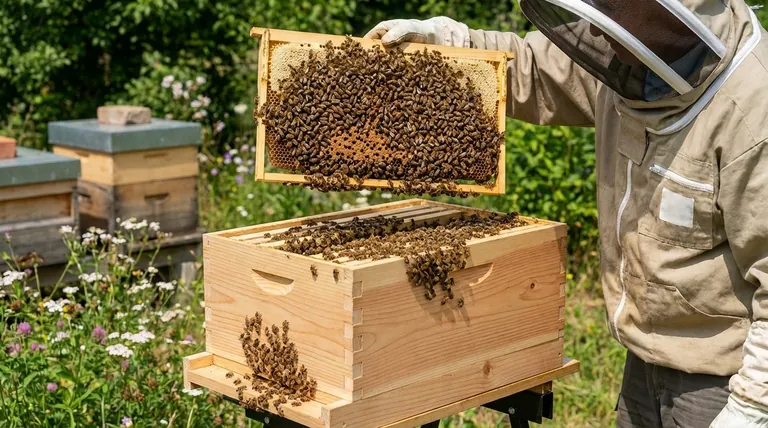When observing a nucleus hive, seeing 80% to 90% of the frames completely covered with a dense layer of bees is the definitive signal that the colony is thriving and has outgrown its current space. This observation is the primary trigger for a beekeeper to begin preparing to transfer the colony into a full-sized hive.
A nucleus hive, or "nuc," is a temporary starter home designed to nurture a young colony. Observing 80-90% bee coverage means the colony has reached its maximum capacity and must be moved to prevent overcrowding and the risk of swarming.

Why "Bee Coverage" Is a Critical Metric
A nuc is a small, confined space, typically with five frames. Its purpose is to give a new queen and a small population of bees a manageable environment to establish themselves. Your goal as a beekeeper is to recognize the moment they have succeeded and need more room to realize their potential.
A Sign of a Healthy, Expanding Population
High bee density is a direct indicator of success. It means the queen is laying eggs prolifically, the worker bees are effectively foraging for resources, and the colony's population is growing rapidly as new bees hatch.
This bustling activity is a positive sign that you have a strong, healthy colony with a productive queen.
The Tipping Point Before Overcrowding
Bees are hardwired to manage their space. When they begin to feel crowded, and the queen has limited empty cells in which to lay eggs, they instinctively initiate swarm preparations.
Seeing 80-90% coverage means the hive is at this tipping point. The bees are telling you they are running out of room for brood, honey, and pollen, which will soon limit their growth and could trigger them to leave.
Looking Beyond Just Bee Numbers
While bee coverage is the first and most obvious sign, a complete assessment confirms the health of the colony. When you see this level of population, you should also spot-check for a consolidated brood pattern.
This means looking for frames containing large, solid patches of eggs, larvae, and capped brood. High bee numbers combined with excellent brood patterns are the definitive green light for a hive transfer.
Understanding the Trade-offs: The Importance of Timing
Transferring a nuc into a full-sized hive is one of the most critical steps in establishing a new colony. The timing of this move is a balance between two key risks.
The Risk of Moving Too Late: Swarming
If you wait too long after the nuc is full, the colony's natural swarm impulse will take over. The bees will raise a new queen, and the original queen will leave with up to half of the workforce.
This event, called swarming, results in a significant loss of your bees. The 80-90% coverage rule is your best tool for preventing this and keeping your strong colony intact.
The Risk of Moving Too Soon: Chilled Brood
Conversely, moving a colony that is too small (e.g., only covering 50% of the frames) into a large, cavernous hive body is also dangerous. The small population of bees will struggle to maintain the necessary temperature (around 95°F or 35°C) to keep the developing brood warm.
This can lead to chilled brood, which will die and set the colony's growth back significantly. The bees will be forced to expend energy on thermoregulation instead of expansion.
How to Apply This to Your Hive
Making the right decision comes down to a simple, systematic observation.
- If your primary focus is proactive management: When your nuc shows 80-90% bee coverage with good brood patterns, transfer the colony into their full-sized hive within the next few days to prevent swarming.
- If your colony shows moderate coverage (60-70%): The bees are doing well but are not yet at a critical stage. Do not transfer them yet; check again in another 5-7 days.
- If your nuc has low coverage or poor brood patterns: Do not transfer the colony. A weak population in a large space is a recipe for failure. Instead, investigate potential issues like a failing queen or disease.
Trusting this key indicator empowers you to support your colony's growth at the most critical moment.
Summary Table:
| Bee Coverage | Colony Status | Beekeeper Action |
|---|---|---|
| 80-90% with good brood | Thriving, at capacity | Transfer to full hive immediately to prevent swarming. |
| 60-70% | Growing well | Monitor closely; check again in 5-7 days. Do not transfer yet. |
| Below 60% or poor brood | Weak, potential issues | Investigate for queen failure or disease. Do not transfer. |
Ready to support your thriving colony with the right equipment? A successful hive transfer requires durable, well-designed supplies. HONESTBEE supplies commercial apiaries and beekeeping equipment distributors with the high-quality, wholesale-focused gear needed for healthy hive expansion. Ensure your operation's success—contact our experts today to discuss your needs!
Visual Guide

Related Products
- 5 Frame Wooden Nuc Box for Beekeeping
- Twin Queen Styrofoam Honey Bee Nucs Mating and Breeding Box
- Automatic Heat Preservation 6 Frame Pro Nuc Box for Honey Bee Queen Mating
- Portable Bee Mating Hive Boxes Mini Mating Nucs 8 Frames for Queen Rearing
- Styrofoam Mini Mating Nuc Box with Frames Feeder Styrofoam Bee Hives 3 Frame Nuc Box
People Also Ask
- How many frames does a typical wooden nuc box hold? A Guide to Choosing the Right Size
- What are the benefits of using nucs for beginning beekeepers? Ensure a Successful First Hive with a Head Start
- What is the purpose of having a nuc in beekeeping? Build a Resilient & Productive Apiary
- What frames should be moved into the queenless hive when requeening with a nuc? Ensure a Successful Queen Introduction
- What is a common feature of many 5-frame nuc boxes? The Integrated Feeder for Efficient Colony Growth



















